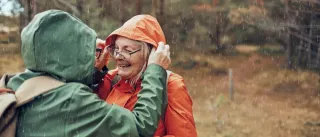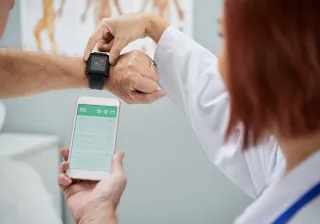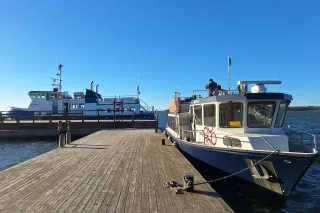How would a transportation robot support the everyday activities of the nurses of an assisted living facility? This was the question studied when VTT Technical Research Centre of Finland Ltd and Tampere University of Technology (TUT) carried out a three-day transportation robot trial in the Keinupuisto assisted living facility in Hervanta, Tampere, in September 2018. The trial was part of the Robots and the Future of Welfare Services (ROSE) project, and the robot used was TUT’s MiR robot. VTT was responsible for the design and implementation of the usage trial. The robot assisted nurses in their daily transportation tasks and it was summoned with a push of a button on a phone application. The nurses did not feel daunted about using the robot and they used it with confidence. They wished that they could use the working time thus saved for encounters with the residents.
VTT researchers had visited Keinupuisto already earlier to see the local facilities and how the place operated day-to-day. They had interviewed nurses and other staff about their work and the transportation needs that come up in their work. There are numerous transportation needs, of which transportation of food from the kitchen to the rooms of the residents and transportation of equipment (e.g. detergents, facecloths) were the most essential and best suited for this trial. Therefore, we began to plan the transportation robot trial together with the Keinupuisto staff. The nurses had told us that supplies are often fetched from the supply room downstairs one at a time, when they are needed. “It would be great if the supplies were readily available, for example, in a single box, from where we could take items to stock up each resident’s own storages,” envisioned one of the nurses. The benefits the nurses estimated they would reach with a transportation robot were improved work ergonomics and reduced need to “run back and forth”. The MiR robot is not suited for outdoor use, so such tasks as taking rubbish to a bin shelter did not come into question.
The MiR robot is controlled with a phone application in such a manner that all stops (e.g. the doors of the residents’ rooms, kitchen, supply storage), where the robot can be sent or summoned to with a push of a button, have been programmed into the user interface. A nurse carries the phone. The user interface is based on a map into which all the routes and rooms where the robot is supposed to move have been coded. Furthermore, the robot can be steered freely with the help of controls found on the phone.
At the beginning of the transportation robot trial, in collaboration with user experience researchers the technical developers involved in the project designed the robot user interface on a phone, programmed the stops for the robot, installed a box suited for transportation needs on top of the robot frame and prepared the robot for use in an assisted living facility. We also discussed the programme and transportation needs of the next few days with the nurses who had shifts on those days. A training session was held for the assisted living facility staff, where they were given a chance to practice the use of the robot. The robot assisted nurses for the following two days, with the researchers observing the use situations. The nurses were motivated to use the robot also when the researchers were not present, and they reported on its use to us.
During the trial, the robot was involved in transporting breakfast, lunch and afternoon coffee, and distribution of supplies to the rooms of the residents, transferring a laundry bag, transporting paper to the shredder, transportation of medicines (at which time the box was locked) and transferring a heavy object from one room to another. “No need to carry by hand!” commented the delighted nurse, when she had the robot carrying the supplies. The Keinupuisto staff decided to call the robot Mirja. They also wanted to attach a smiley face sticker on the robot to reflect a good mood and a happy mind. The robot had a resting place in the lobby area of the assisted living facility, where it could be sent to wait for the next assignment. The place where the robot was summoned for the night to be recharged was named the home base. The home base was in a location covered by a CCTV camera.
The residents of the assisted living facility were curious about the robot, and some of them were even slightly suspicious. The nurses were understanding and very patient, when Mirja was sometimes looking for the right route or dropping off the map. For example, the operation of the Wi-Fi network posed some challenges. When using a lift, Mirja needed assistance from a nurse to push the lift button and hold the lift door open. Most journeys on a lift went without problems, but sometimes nurses had to wait for Mirja to arrive. In problem situations, it is extremely important that the application has a main user, who knows how to seek solutions in challenging situations. In spite of a few problem situations, the nurses had confidence in the system and they got better at using the robot. For example, the nurses let the robot precede them or walked ahead of it, knowing that the robot would follow.
For us as researchers, the days in Keinupuisto were very rewarding, as both us and the transportation robot were allowed to become part of the everyday life of the assisted living facility. We want to thank the Keinupuisto staff for their cooperation. We had an opportunity to follow how a great team of nurses worked and how fearless they were about the robot and its use. The trial did not go totally without incident, but together with the nurses we came up with new ideas for using transportation robots. This use trial was the first time we took the transportation robot out to the field, i.e. made it available for the use of the nurses at the assisted living facility. During autumn, we intend to organise a similar trial in another assisted living facility, and next year a longer trial that will provide us with more reliable data on the suitability of a transportation robot for use at an assisted living facility. The start seems promising.








